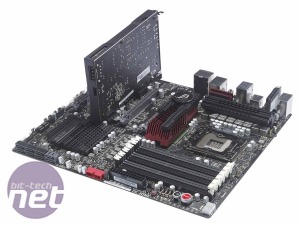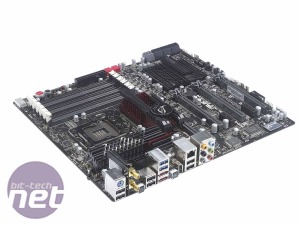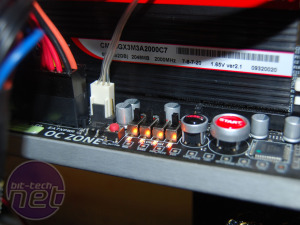
Overclocking
Beyond the overt additions and extras strewn around the PCB, the actual construction of the board itself tells you it’s for extreme overclockers. The heatsinks feature the new Republic of Gamers design, with rows of finely detailed extrusions and notches rather than the Escher-esque angled blocks of the previous generation. Underneath the chipset and VRM heatsinks are eight power phases, controlled by the RoG Extreme Engine Digi+ processor. This also controls the three-phase memory, chipset and QPI link power circuits, and lets you change the frequency at which these operate, just as with Asus’ P67 range.If the extreme overclocker status wasn’t clear from just looking at the board and reading the detailed manual, the BIOS really sets the R3B apart. This isn’t just because the background colour is as black as the board itself, but because the range of options presented in the AI Tweaker menu is as extensive as we’ve seen from a motherboard. Only some of DFI’s infamously overstuffed BIOSes can compete with the feeling of being overwhelmed, and only then because the way in which DFI’s BIOSes referred to components and options was notoriously esoteric.
Click to enlarge
After scouring the AI Tweaker menu, it’s clear that a fair amount of logic has been applied. Options are grouped by function, so essential frequencies are all collated in the top section and then each section down deals with another aspect of overclocking the board. However, we saw a fair bit of repetition of features already served via the buttons and switches on the board itself.
Meanwhile, a second-level menu oddly titled GPU.DIMM Post lists which PCI-E slots are filled, and the status of each card installed in them (a quick way to tell if a graphics card has died). As the name cryptically suggests, this section is also joined by a similar section for the six memory slots, letting you troubleshoot faulty DIMMs quickly too.
As this is a super-overclockable motherboard, we've deployed our turbo-nutter test gear to really push the R3B to its limits. This included a Hailea HC-500A water chiller, a Laing D5 pump and a Swiftech Apogee XT waterblock. As expected, the R3B was able to run the QPI at the usual 220MHz maximum that we’ve seen from the best X58 motherboards. Even pushing the QPI to 225MHz was too much, as it was on every other board we’ve tested – no matter what voltages we used or BIOS tweaks we made. With that established, we moved on to the main event: CPU overclocking under pre-chilled water.
Click to enlarge
Overclocking the R3B can be a quick process or a hugely lengthy one – you can either scroll down the AI Tweaker menu to the Asus OC Profile entry and hit Enter, or you can go through the 20-odd individual overclocking settings to see which are useful. We did both. However, after playing with everything from the CPU QPI Strength to the CPU Differential Amplitude, and from the CPU PWM frequency to the QPI PWM frequency, we found that the automatically loaded Asus OC Profile got the various settings just right.
We did most of our fiddling with the plethora of fine-tuning settings with our CPU overclocked to 4.738GHz via a combination of a 206MHz QPI and a 23x CPU multiplier. To make this stable, we had to push plenty of voltage through the board – you can see the list of our voltages in our Testing Method summary. However, we would only use such high voltages in combination with water-cooling and the Hailea water-chiller; you would seriously risk damaging your hardware if you used such absurdly high voltages with air-cooling. As well as chilling the CPU, we positioned two high-airflow fans over the chipset and CPU VRM heatsinks, and a third fan over the Southbridge heatsink.

MSI MPG Velox 100R Chassis Review
October 14 2021 | 15:04












Want to comment? Please log in.